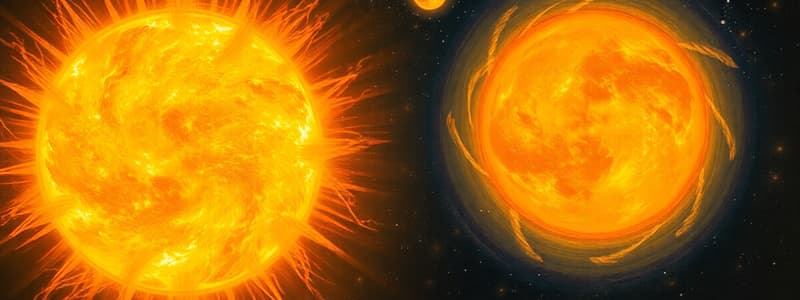Podcast
Questions and Answers
Match the following solar atmospheric layers with their primary gas components:
Match the following solar atmospheric layers with their primary gas components:
Photosphere = Ionized hydrogen and helium Chromosphere = Mix of ionized atoms and free electrons, hydrogen and helium Corona = Ionized gases, including highly ionized iron and other heavy elements Solar Wind = Continuous stream of charged particles (plasma)
Flashcards
Composition of the Sun
Composition of the Sun
The Sun is mainly made of hydrogen (73%) and helium (25%), with trace elements like oxygen and iron.
Photosphere
Photosphere
The visible surface of the Sun, composed mostly of ionized hydrogen and helium.
Solar Plasma
Solar Plasma
A hot state of matter in the Sun where electrons are free from atoms, consisting of ions and electrons.
Solar Wind
Solar Wind
Signup and view all the flashcards
Solar Atmospheric Layers
Solar Atmospheric Layers
Signup and view all the flashcards
Study Notes
Composition of the Sun
- The Sun is primarily composed of hydrogen (73%) and helium (25%). These two elements constitute over 98% of its mass.
- Trace amounts of heavier elements (oxygen, carbon, neon, iron) are also present, but in smaller quantities.
- The Sun's composition aligns with stellar nucleosynthesis, where lighter elements fuse into heavier ones, providing a crucial energy source for stars.
Solar Atmospheric Layers and Gases
- The Sun's atmosphere has layered structures with distinct compositions.
- The photosphere, the visible surface, is mainly ionized hydrogen and helium. Heavier element abundance decreases moving outward to the chromosphere and corona.
- The chromosphere, above the photosphere, contains ionized atoms, free electrons, along with hydrogen and helium. This layer experiences a significant temperature increase.
- The corona, the outermost layer, has a very low density and high temperature. It is primarily composed of ionized gases, including highly ionized heavy elements like iron. Though less abundant than in the photosphere, the presence of these ions is notable due to the extreme temperatures.
- Gas distribution in the solar atmosphere isn't uniform. Areas like sunspots and coronal loops show different compositions affecting magnetic fields and phenomena like prominences, crucial for understanding solar activity.
Solar Plasma and Gases
- The Sun is a hot plasma, not a solid.
- Plasma is a state of matter with stripped electrons, creating a mixture of positively charged ions and free electrons.
- This plasma state impacts energy transport and magnetic fields within the Sun.
- Charged particles and gases contribute to solar magnetic activity and solar wind generation.
- The solar wind is a continuous stream of charged particles from the Sun, carrying insights into its magnetic field and composition.
Sun's Core and Gases
- The Sun's core, with its immense pressure and temperature, differs significantly from the surface.
- The core primarily contains highly compressed hydrogen and helium plasma.
- This dense, hot plasma is the site for nuclear fusion reactions, converting hydrogen into helium and releasing enormous energy.
Gas Pressure and Temperature
- The Sun's energy output relies on core pressure and temperature.
- Pressure gradients and temperature differences drive energy outward through the solar layers, affecting gas distribution and movement, critical for solar activity.
Solar Gas Motion
- Solar gases are constantly in motion, driving phenomena like photospheric convection currents and the solar wind.
- Convection plays a key role in transferring energy from the core to the surface, influencing gas behaviors throughout various solar layers.
- Motions, driven by pressure and magnetic forces, contribute to the Sun's dynamic character.
Studying That Suits You
Use AI to generate personalized quizzes and flashcards to suit your learning preferences.




